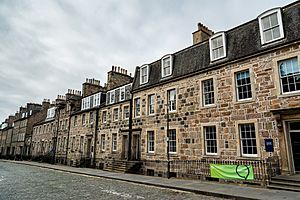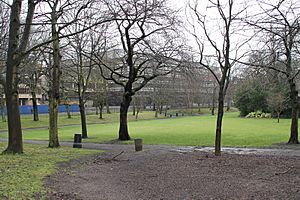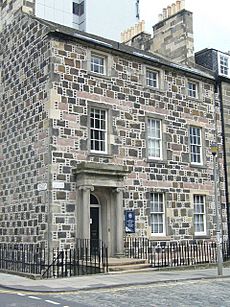George Square, Edinburgh facts for kids
George Square (which is Ceàrnag Sheòrais in Scottish Gaelic) is a famous city square in Edinburgh, Scotland. You can find it in the south part of the city centre, right next to a big park called the Meadows. It was first built in 1766, outside the very busy and crowded Old Town. Back then, it was a popular place for Edinburgh's wealthier citizens to live. In the 1960s, a lot of the square was changed by the University of Edinburgh. Even though groups like the Cockburn Association protested, many new university buildings were constructed. Today, most of the buildings around the square belong to the university. Some important buildings there include the Gordon Aikman Lecture Theatre, the Edinburgh University Library, 40 George Square, and Appleton Tower.
Contents
Discovering George Square's History
George Square was created in 1766 by a builder named James Brown. It had simple, yet elegant, terraced houses built in the popular Georgian style of the time. People wanted to move away from the very crowded Old Town, so George Square became a popular home for important lawyers and nobles.
Many famous people lived here. Sir Walter Scott, a very well-known writer, once called George Square home. So did Arthur Conan Doyle, who later wrote the exciting Sherlock Holmes novels. He lived at number 23 from 1876 to 1880 while he was studying medicine at the University of Edinburgh Medical School. In June 1792, the square was even the starting point for some protests called the Dundas Riots. These protests were aimed at the house of a politician named Robert Dundas of Arniston, who lived on the square.
Changes Over Time
The square started to change in the late 1800s. For example, numbers 4 to 7 were rebuilt to become George Watson's Ladies College. This college then grew even bigger in the 1920s.
However, the biggest changes happened in the 1960s. The University of Edinburgh decided to build many new facilities. This meant that the entire south side of the square, and half of the east side, were taken down. These new university buildings, along with others nearby, made George Square the main centre for the whole university.
Exploring the Gardens
The gardens in the middle of George Square are privately owned. This means they are not a public park like some others. However, people are usually allowed to use them, though often only one entrance is open.
Inside the gardens, you can find a special memorial to Winifred Rushforth called "The Dreamer." The garden also has several unique "Baillie lamps." These lamps used to be placed in front of the homes of important Edinburgh officials called Baillies. Later, until the 1970s, they were in front of councillors' houses.
The paths next to the central garden have a special surface called "horonised pavement." This is a clever way of using leftover pieces of granite from when the main road was built, so nothing goes to waste!
George Square Today
The University of Edinburgh started planning to update the square in the 1950s. Famous architects like Basil Spence and Robert Matthew were involved. Many people, including the Cockburn Association, protested against tearing down the old Georgian buildings. In the end, the western side of the square was saved. This was partly because the Dominican Order, who owned numbers 23 and 24, refused to sell their buildings to the university.
Today, George Square has the most university buildings in its central campus area. These include the Brutalist-style Gordon Aikman Lecture Theatre, the university's main library, and the Appleton Tower and 40 George Square buildings, which are used for teaching and administration.
George Square and the Edinburgh Fringe
Every August, George Square becomes a very busy and exciting place during the Edinburgh Festival Fringe. This is a huge arts festival! Many of the university buildings, like the Gordon Aikman Lecture Theatre and the lecture halls in 40 George Square, are turned into performance venues for the festival.
The gardens also fill up with temporary bars and pop-up venues. In recent years, while a nearby area called Bristo Square was being renovated, the famous purple cow venue of the Underbelly festival group has also been set up here. It's a lively and fun time for the square!






